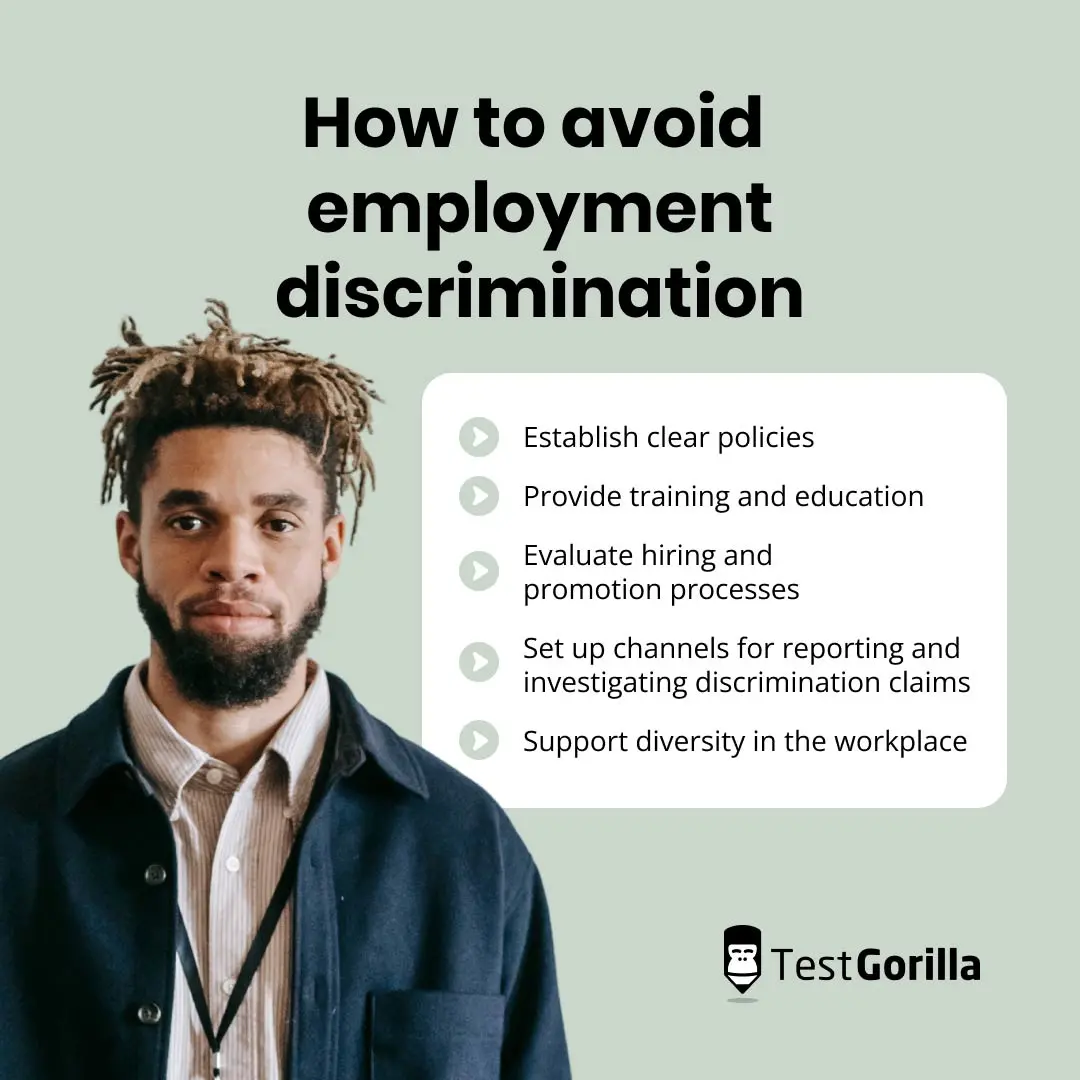Creating a workplace where everyone is treated fairly is important, but it’s not always easy. HR managers have to navigate complex legal requirements while ensuring that unconscious bias doesn’t lead to discriminatory actions.
The best way to remove discrimination from the workplace is to learn to recognize it, create awareness of its forms, and implement processes that actively avoid it.
This guide sheds light on the personal characteristics protected by law and the types of workplace actions that can lead to employment discrimination claims. We also share tips on how to avoid employment discrimination by improving workplace practices.
Table of contents
What is employment discrimination?
Employment discrimination is the illegal act of treating employees or job applicants unfairly based on their personal characteristics.
Specific characteristics are protected by law and include race, sex, age, disability, religion, and more. Discrimination can arise in all stages of the employment relationship, such as hiring decisions, promotions, and terminations.
Discrimination vs. harassment
When most people think of employment discrimination, they think of unfair treatment discrimination.
Although unfair treatment and harassment are related, they are distinct types of discrimination. Both involve illegal action based on protected characteristics but differ in the type of action taken against an employee.
Unfair treatment is a type of discrimination that occurs when an employee is subjected to negative actions in an employment decision based on their protected characteristic. For example, a supervisor who refuses to promote an employee because they are over 40 years old has likely discriminated against that employee.
Harassment, on the other hand, occurs when an employee is subjected to unwelcome and offensive conduct at work based on a protected characteristic. For example, if the same supervisor consistently made offensive jokes or comments about the same employee’s age, they have likely harassed the employee.
Unfair treatment and harassment are both illegal forms of discrimination, and harassment is addressed in the same laws that make unfair treatment discrimination illegal. These are not the only forms of workplace discrimination, but they are the most commonly discussed.
What does discrimination at work look like?
Workplace discrimination starts when an employer takes certain actions against an employee or job applicant based on a protected characteristic. The types of actions that may lead to discrimination claims include:
Unfair treatment
This refers to action against an employee or job applicant directly related to their employment. For instance, refusing to hire a job applicant because of their race is a form of unfair treatment discrimination.
Harassment
As discussed above, harassment is a form of discrimination where the individual is exposed to offensive conduct.
Sexual harassment, where an employee is consistently subjected to unwelcome and offensive jokes or lewd remarks, is a common example of this form of discrimination.
Denying a reasonable change
If an employee requests a change to their work based on a protected characteristic, denying the change can be a form of illegal discrimination. For example, if an employee requests a reasonable accommodation for their disability, refusing to grant it could be a form of discrimination.
Inappropriate actions regarding protected data
Asking for or improperly disclosing private medical data or genetic information can be a form of discrimination. For example, making details of an employee’s medical condition known to all employees in the workforce could lead to discrimination claims.
Retaliation
Employees and job applicants have a legal right to raise their concerns about work discrimination, and taking action against an individual for using that right is illegal. For example, refusing to promote an employee because they previously claimed they had suffered discrimination at work could be considered illegal retaliation.
What are protected characteristics in employment discrimination?
Workplace discrimination starts with actions based on protected characteristics. Federal laws prohibit discrimination at work that is based on an individual’s race, color, religion, national origin, disability, age, genetic information, or sex.
Race and color discrimination
Race discrimination occurs when an individual is treated unfairly or subjected to harassment based on their race, or characteristics associated with race, like facial features and hair texture. Meanwhile, color discrimination occurs when unfair treatment is based on a person's skin color.
It’s still possible to discriminate based on race or color when the person who took the discriminatory action and the victim are both the same race or color.
Religious discrimination
Religious discrimination occurs when an employee or job applicant is treated unfairly based on their religious beliefs.
Employers are required to reasonably accommodate employees’ religious practices, such as adjusting schedules to meet worship times or allowing an employee to wear religious dress in the workplace.
On the other hand, employers can’t legally force employees to either participate or refrain from participating in a religious activity as part of their employment.
National origin discrimination
National origin discrimination occurs when an employee or job applicant is harassed or treated unfairly based on their nationality. Examples can include harassing an employee for their accent or refusing to hire a job applicant because of their ethnic background.
Disability discrimination
Disability discrimination occurs when individuals are put at a disadvantage or treated unfairly based on a disability or are improperly perceived as though they are disabled.
Legal protections against disability discrimination provide four main rights in the workplace:
Prohibiting unfair treatment based on an individual’s disability, or unfair treatment as though the individual is disabled
Prohibiting harassment at work based on a disability
Requiring employers to grant requests for reasonable accommodations that enable individuals with disabilities to apply for jobs, perform work, or access the workplace
Limiting employers from asking about an employee’s private health information and requiring employers to protect shared private medical data
Age discrimination
At any stage in employment, from application to termination, employers must not discriminate against people aged 40 or older. For example, passing over a qualified candidate for promotion based on age could be a form of age discrimination.
Genetic information discrimination
Genetic information refers to an individual’s genetic test results, such as data that suggests an increased risk of disease in the future. The law prohibits employers from basing any employment decision on genetic information because it’s never relevant to the person’s current ability to work, even if an employee discloses it themselves.
Sex, gender, and LGBTQ+ discrimination
The federal law prohibiting sex-based discrimination was initially passed with a binary approach to gender in mind. For example, an employer refusing to hire women for any job would discriminate based on sex.
Since the original law passed, protections have been expanded to include characteristics associated with sex and gender. These protections include prohibiting discrimination on the basis of gender identity or sexual orientation.
Harassment is commonly discussed in terms of sex-based discrimination. It’s illegal to harass a person based on their sex, sexual orientation, or gender identity. For example, unwanted sexual advances can be a form of unlawful discrimination.
It’s also possible to engage in sex-based harassment without remarks being sexual, such as making consistent offensive remarks about sexual orientation in general.
Pregnancy discrimination
It’s unlawful to discriminate against an employee or job applicant based on their pregnancy, or conditions related to pregnancy.
The laws protect against discrimination in the workplace in the following ways:
Prohibiting discrimination, including unfair treatment and harassment, based on pregnancy
Requiring employers to provide reasonable accommodations for workers impacted by pregnancy, childbirth, or related health conditions
Requiring employers to provide reasonable accommodations for disabilities that may arise from pregnancy
State definitions of protected characteristics
Several states have adopted additional protected characteristics in their laws. Check the laws in any state where your business operates to ensure compliance.
How to avoid employment discrimination
Establish clear policies
Ensure your business communicates clear anti-discrimination policies and procedures. The US Equal Employment Opportunity Commission (EEOC) recommends including the following in an anti-discrimination policy:
A statement specifying that discrimination is illegal and will not be tolerated by the company
A statement explaining that reasonable accommodations will be provided by the company, including instructions for requesting an accommodation
An explanation of the company’s process for reporting discrimination
A clear statement expressing that employees will not be punished for reporting discrimination
A requirement that supervisors and HR employees report or act on discrimination when they become aware of it
A description of the consequences for violating the discrimination policy, including potential termination of employment
Provide training and education
Regular training on discrimination laws and related company policies promotes awareness of workplace behavior and an understanding of how to report discriminatory actions. Ensure that all employees, from entry-level to leadership, have access to this training.
Bystander training, which teaches employees how to recognize discrimination when they witness it, has become a useful component of training programs.
Additional training that supports a healthy work culture, such as education on spotting and eliminating microaggressions at work, can help bolster anti-discrimination training efforts.
Evaluate hiring and promotion processes
Unfair treatment discrimination often stems from biased recruitment procedures.
Structure your recruitment process to eliminate bias and unfair hiring practices. For example, strive for diverse hiring panels, review applicants based on objective assessment criteria, and conduct structured interviews that ask all candidates the same questions.
One simple way to prevent discrimination in recruitment is to implement skills-based testing. This provides an objective and standardized assessment of candidates’ skills without relying on subjective judgments.
Use pre-employment tests that undergo rigorous validation to ensure they accurately measure skill levels without bias. Implementing skills-based testing as part of the hiring process promotes transparency and fairness while reducing the potential for discrimination.
Beyond recruitment, promotion and compensation decisions should be based on merit, skills, qualifications, and experience, rather than discriminatory factors. Regularly review these processes to identify and correct any disparities.
Set up channels for reporting and investigating discrimination claims
Encourage open communication that lets employees express their concerns without fear of retaliation. The best reporting processes provide several reporting points, such as:
A supervisor or manager
An HR staff member
An anonymous reporting channel
When a report is made, an investigation needs to be conducted in line with your company policies. This may be handled by a qualified member of the HR team, an attorney, or an external investigator. Any investigation should maintain confidentiality when possible and keep involved parties informed about the progress and outcome of the investigation.
Support diversity in the workplace
Promoting diversity through recruitment and encouraging an inclusive culture can help prevent discriminatory behaviors from taking root. Employees are also more likely to report discrimination if they believe it’s counter to company values.
The organizations that protect against discrimination
Individuals who wish to file a discrimination complaint can reach out to one of these government organizations:
US Equal Employment Opportunity Commission (EEOC)
The EEOC is in charge of enforcing federal anti-discrimination laws in the workplace. Individuals can file complaints with the commission directly or they may be referred to a state government office for handling.
State government offices
The definition of prohibited employment discrimination exists in federal and state laws in the US. All states must prohibit employment discrimination at least at the level outlined in the federal law, but some states have laws that provide greater protection to employees. For example, California has adopted laws that prohibit workplace bullying.
Each state has a designated government agency that handles claims of workplace discrimination. The US Commission on Civil Rights maintains an updated list of every state’s agencies. These agencies are also an excellent resource for employers who need guidance on their state’s laws.
Health and Human Services Office for Civil Rights (OCR)
The OCR enforces anti-discrimination laws specifically regarding health care providers and health insurance plans. The agency also provides guidance on the proper use and disclosure of health information.
Take action now to keep discrimination out of your organization
Employment discrimination remains a challenge in workplaces. However, understanding how discriminatory actions can arise and identifying when breaches have been made helps to put preventative measures in place.
Training your HR team to regularly review your business policies and processes is an excellent step toward protecting your organization from employment discrimination claims.
You can remove discrimination from your hiring process by integrating skills-based testing. Objective assessments avoid the influence of unconscious bias and prevent perceptions of unfairness from arising.
Sign up for a free demo today to see how TestGorilla can help you build a faster and fairer hiring process.
Related posts
Hire the best candidates with TestGorilla
Create pre-employment assessments in minutes to screen candidates, save time, and hire the best talent.
Latest posts
The best advice in pre-employment testing, in your inbox.
No spam. Unsubscribe at any time.

Hire the best. No bias. No stress.
Our screening tests identify the best candidates and make your hiring decisions faster, easier, and bias-free.
Free resources
This checklist covers key features you should look for when choosing a skills testing platform
This resource will help you develop an onboarding checklist for new hires.
How to assess your candidates' attention to detail.
Learn how to get human resources certified through HRCI or SHRM.
Learn how you can improve the level of talent at your company.
Learn how CapitalT reduced hiring bias with online skills assessments.
Learn how to make the resume process more efficient and more effective.
Improve your hiring strategy with these 7 critical recruitment metrics.
Learn how Sukhi decreased time spent reviewing resumes by 83%!
Hire more efficiently with these hacks that 99% of recruiters aren't using.
Make a business case for diversity and inclusion initiatives with this data.


















